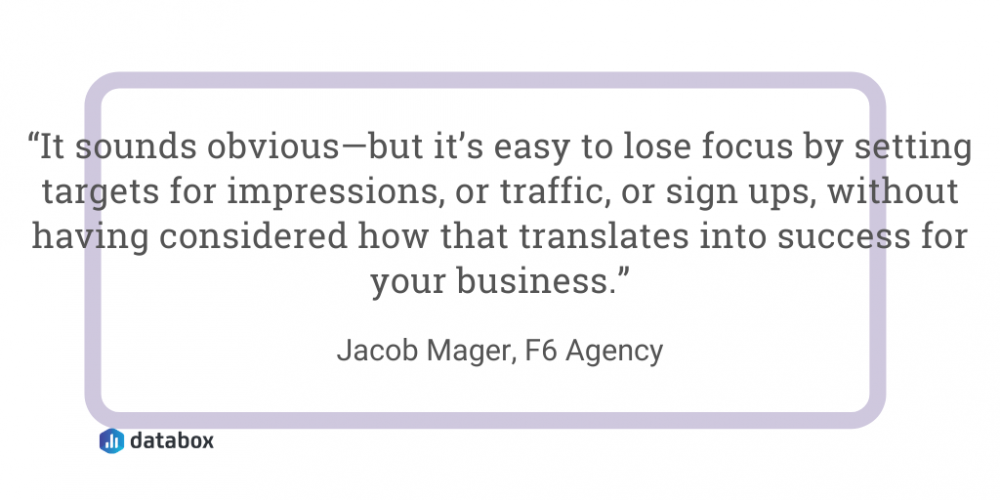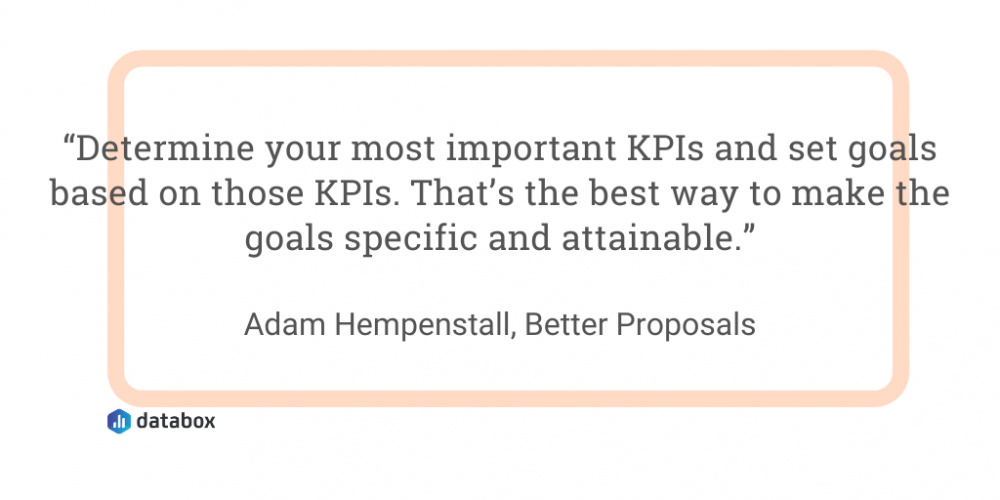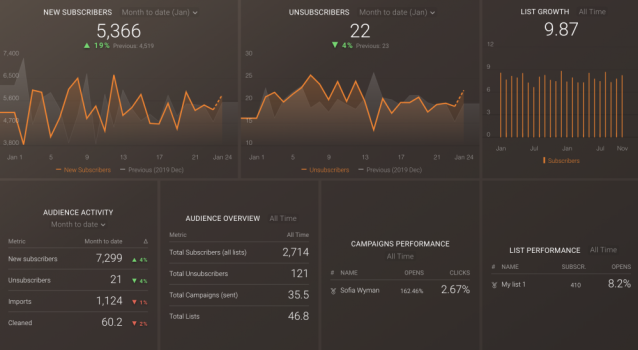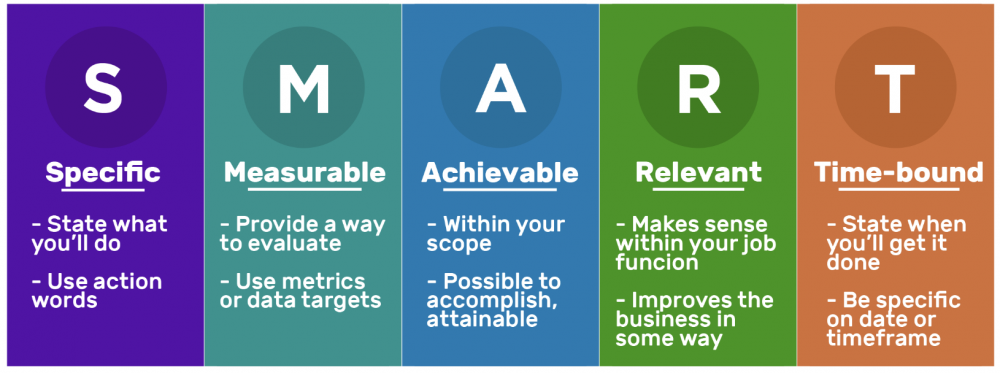Do you ever avoid setting long-term marketing goals because you’re not confident you can hit them?
Don’t worry, you’re not alone. Many of us marketers feel that way.
When it comes to setting goals for specific campaigns or other short term initiatives? No problem.
But we often get uncomfortable when talking about the long-term. Why? Because there are so many unknown variables at play. You essentially need to plan ahead for a reality that, well, isn’t a reality just yet.
What type of volume will you need throughout your funnel? Which resources will you need to achieve that volume? How about headcount––do you need to hire additional people before then?
Setting long-term marketing goals is a daunting task and one that many marketers avoid in fear of not hitting them. Or, they avoid them simply because they’re unsure of how to go about setting them correctly.
So, what are the best ways of thinking long-term? We asked dozens of marketers to help out. We hope this helps alleviate any fear you might face when setting your long-term marketing strategy.
Why are long-term marketing goals important?
Before we dive in with the details, you might be struggling with one question: Why bother creating long-term marketing goals?
“One effective way to set long-term marketing goals is to think into the future and come up with goals that will set you up for a lifetime of success,” Money Crashers‘s Carly Fauth says.
“That’s not to say that short-term marketing goals have no place in your strategy, but in today’s competitive business environment, it can be easy to forget about the long-term.”
“So again, while there’s nothing wrong with trying to get your first 1,000 followers on Twitter, you should also think about things that will help your business long-term, such as leveraging search engine optimization to its fullest.”
Fauth continues: “This is a broad goal that will take time and effort and it won’t be achieved overnight. Plus, how to achieve success in that realm changes over time so you’ll need to throw that into the plan of achieving that goal.”
How long is “long-term”?
Long-term can have different meanings for different people.
For the team at Green Thoughts Consulting, Jeff Green says: “Long term goals are usually 12 to 18 months.”
However, the duration of a long-term goal can depend on the activity, as Robert Moses of The Corporate Con explains: “One of our most important marketing goals is attaining the number one position on Google for a list of our keywords. This is done via SEO and can take 6-months to a year to achieve, depending on the competitiveness of the keyword.”
But there could be a disadvantage to creating longer goals, according to Alberto Carniel: “Distant goals have two main disadvantages: The team doesn’t feel enough pressure and let loose. It’s easy to underestimate the workload and race against the clock to meet deadlines.”
“The second drawback is to feel overwhelmed. Distant objectives are usually ambitious. People have different reactions to stress and may not feel capable to fulfill their tasks.”
Growth Hackers‘ Jonathan Aufray adds: “A great example of long-marketing goals is brand recognition, visibility, and exposure. This is not something you work on a short-term period and that you can easily track the progress week after week. You can evaluate your brand recognition after a long time only.”
How to plan long-term marketing goals
You’re ready to create long-term goals for your marketing team… But you’re not sure where to start.
We asked a handful of experts to share how they do it.
1. Match marketing goals to business-wide goals
When creating long-term marketing goals, Jacob Mager of F6 Agency advises to “keep your marketing goals aligned with your overall business goals.”
“It sounds obvious—but it’s easy to lose focus by setting targets for impressions, or traffic, or signups, without having considered how that translates into success for your business.”
“Knowing where you want your business to be in terms of short and long term revenue tells you how much new business you’ll need to bring in… which will inform how you go about achieving that end result,” Mager adds.



Tacuna Systems‘ John Flanagan explains: “If for example, your company goal is to increase sales by 25% in three months, you need to specifically identify how many leads, MQLs, SQLs, closing rates, etc, that you need to achieve this goal. You can now take these data and set them as marketing goals.”
Vera Mirzoyan of AIST Global explains what that might look like: “Once I set a marketing goal to double the organic traffic of our website in 6 months.”
“Then I made a plan of expected actions to achieve this goal. Those actions included: optimize the website, implement both on-page and off-page SEO, generate backlinks, share links, analyze keywords, rank the pages, etc.
“You see? Everything comes from business objectives which, in this case, was to increase the number of potential customers. To increase this number we needed to reach more people. To reach more people, we need to increase website traffic. So, we choose the organic way,” Mirzoyan adds.
Kent Lewis of Anvil Media summarizes: “Marketing goals are not meaningful if they do not move the needles that matter for the business.”
2. Plan for your company’s future
It’s not just your most obvious business goals you’ll need to consider when creating long-term marketing goals, though.
According to My Trading Skills‘ Joe Bailey, “one effective way of setting long term marketing goals that will actually work is having a clear picture of where you expect the company to be in the future. This will involve conducting a risk review and determining the likely future of the company.”
“It is also imperative that as a marketer, you are able to tie the business vision/mission to the future of the company. The long term marketing goals should be based on this connection.”
3. Plan goals based on last years’ data
“When defining your long-term goals, the simplest way to start is to understand what’s already working. Gain a deep understanding of your buyers by analyzing historical customer data and sales,” says Angela Hawkins of Voices.
“Determine how to get more of your best customers and focus energy on goals that align with what is naturally driving your business. Couple this knowledge with knowledge of the competitive landscape and trends in the industry and you can create long-term goals that are rooted in the understanding of your customer.”
Julia Brolin of Leighton Interactive puts that into practice: “For example, your company has a revenue goal of X. You currently generate X leads. Of those leads, your close rate is X, and the average retainer is X.”
“If you know what the revenue needs to be, you can use pulse metrics to hit future goals and create a marketing strategy around the pulse metrics to support revenue.”
Malte Scholz also says the team at Airfocus has a similar approach: “The best way to set long-term marketing goals is to take a look in retrospect and find out what you did well in the previous years.”
“For us, we’ve done great with paid ads, whether it’s Google or social media platforms, and we’ve gotten good results from this method. However, we’ve seen that over the years, we haven’t done very well in terms of content marketing. So, we set our aims on content marketing and increasing our traffic and building links in 2020.”
Portent also uses this technique, according to Kirsten Pickworth: “Creating long-term marketing goals from your historical data in Google Analytics and analyzing trends and seasonality will help you make an informed projection for a percentage increase in traffic or conversions in the next year.”
“Then, you can create milestones for each quarter and build a roadmap of projects or campaigns that will help you make measurable progress toward the goal and re-forecast, if needed.”
This quarterly recap could be the perfect place to set new marketing goals–especially as almost half of our experts use this timescale for goal-setting:



4. Run a SWOT analysis
“Typically, companies and entrepreneurs that want to break into a market in which they already have a core competency but want to gain market share should engage in a quick review,” James Rogers of Saint Mary’s College advises.
“By examining their position on the BCG (Boston Consulting Group) Matrix with a SWOT analysis, they can gain strategic insights for setting long-term marketing goals.”
“For example, if they find themselves in the “Question Mark” category, there might be an opportunity to take advantage of rising sales trends, and now just need to develop a strategy and tactics to gain market share.”
Rogers explains how they did this recently: “One client example is a motorsport company that wants to grow but was unsure how to compete with a giant like Harley Davidson — who would clearly be in the “Star” category.”
“The SWOT analysis will reveal that Harley is weak in the youth, and sports bike markets, providing an opportunity for this competitor to grow. So that leaves an opening to target marketing efforts with events and refined ad placements aimed at the newly defined market opportunity.”
“In this scenario, the client decided to host free kids demo ride days, even offering training wheels on dirt bikes. Families can attend, kids get to ride and get their pictures taken which are then posted (with permission of course) on social media. Events such as these, drawing them into the sport and cultivating the market even before ready to purchase.”
Rogers continues: “Long-term marketing goals, such as this example, are almost always set annually. Start by assessing your objectives over a long-term period and be sure goals set have a prospect of victory.”
“Even if achievable, you still have to manage your expectations and be realistic about the annual progress you’ll see. Know your baseline data before you start implementing the marketing plan and then plan to look at KPIs (key progress indicators) on a quarterly basis.”
“In our example, this client might want to track how many people showed up, what type of engagement they received on social media channels, and what the ROI was for the event,” Rogers summarizes.
Dai Baker agrees: “Before creating a goal, be sure to conduct a SWOT analysis. The results will provide a complete picture of the current marketing position along with opportunities to improve.”
“Using these results, create long-term marketing goals. Using this method, you are actually creating marketing goals that are needed versus creating goals that are not necessarily important or realistic.”
5. Attach measurables to long-term marketing goals
When we asked Better Proposals for their best way to plan long-term marketing goals, Adam Hempenstall’s answer was simple: “Determine your most important KPIs and set goals based on those KPIs. That’s the best way to make the goals specific and attainable.”
“For example, if you set your goal as “increasing your brand awareness in 2020” without attaching a specific KPI to it, you’ll never know if the goal is truly met.”
Hempenstall puts this into practice: “Our marketing goal for 2020 is to increase our organic traffic by 30%. We’ve had excellent conversions from organic traffic so we hope to make a significant increase this year. I think that we can do much more than 30%, but we’ll see how things go and re-set our goal at the beginning of Q3 if necessary.”



Tung Dao of Avada Commerce advises: “Figure out exactly what you want at the end of the campaign, then find the most reliable metric to measure progress. Set your goals based on that metric.”
6. Follow the SMART goal framework
“To make marketing goals that stick, you need to make the SMART, break them up by milestones or steps, and measure frequently,” writes Brian Cairns.
The SMART acronym is a popular framework for goal-setting:
“For example, we have a goal to help build brand awareness of our company ProStrategix Consulting. One of the long-term strategies is to use LinkedIn to help boost our brand awareness with a professional audience.”
Cairns goes on to break down how this goal fits within the SMART framework:
- “Specific: Increase our average daily post views and likes on LinkedIn
- Measurable: We track the views to our posts, daily, weekly, monthly, and 3 mos. We have KPI for 1 mo and 3 mos
- Achievable: Our KPIs are built using a data regression using our past 4 months of posts, and they are updated monthly to ensure we are on track and setting reasonable expectations
- Relevant: Post views and likes are a clear indication of reach. Through increased reach and interaction (likes), we can make the logical leap that it is helping awareness
- Time–bound: We have KPIs for the given month, 3 mos rolling average, and end of year target, including a 12 mos rolling average.”
Bill Sebald says that Greenlane also follows the SMART framework because “making sure your goals pass these qualifiers gives them a realistic chance of being hit. From there, it’s simply a matter of checking in often and executing your milestones effectively.”
However, Search It Local‘s Alexander Porter thinks the most important part of a SMART goal is its achievability: “The most important thing to include in your marketing goal is a healthy dose of reality.”
“Setting yourself loft targets is fine, this can help teams reach for greatness, but unless that goal is tangible you’ll never be successful.”
“The difference between ‘grow our social media accounts’ and ‘increase Instagram follower count by 15% month on month in 2020’ is more than a matter of semantics. The former is a vague goal with no finish line, the latter can be tracked, measured and tweaked to achieve,” Porter says.
“When setting long-term marketing goals, ensure they are concrete and well defined. These goals should also be followed up to measure the level of success, or, to gauge what went wrong.”
Daniela Andreevska agrees: “Although you should be ambitious and aspiring to grow in the long term, it’s absolutely useful to set up goals which are unrealistic. Once you start falling behind on your goals, both you and your team will feel discouraged and disengaged.”
In fact, Andreevska’s team at Mashvisor is putting this into practice: “For Q1 of 2020 one of our marketing goals is for traffic from YouTube to reach 5% of the total traffic to our website. It currently stands at about 1%. This is a reasonable yet ambitious goal as we are focusing significantly more efforts on video marketing during this period than last year.”
7. …Or the THRIVE framework
Dani Juson of Thrive Marketing also recommends to “use the THRIVE goal-setting technique—similar to SMART objectives, effective marketing goals should be time-bound, heavy-duty, realistic, identifiable and explicit.”
“If a stranger could read your goal and understand the gist of what you’re trying to do, you’re on the right track.”
Juson puts that into practice: “Over the next 3 months, we will double the number of leads generated from our organic Facebook and Twitter activity. Or, in Q1, we’ll generate at least 10 warm, high-ticket leads from the joint venture online summit we’re co-hosting.”
8. Look at your strengths and weaknesses
“The best goals come from two sources: gaps in performance that need to be improved or areas of strength that need to be further leveraged,” writes John Donnachie of ClydeBank Media.
“By honestly looking at your current strengths and weaknesses and arraying them for review it is an effective way to select the best goals (long or short term).”
*Editor’s note: Do you know where your strengths and weaknesses are as a marketing team? Start using our templates designed for each channel–including video, email, and social media–to find where your results are falling (or rising):



Click here to read this article on the Databox website.








